Working principle of electric screwdriver QS-1 series micro switch
The circuit is switched on and the tool head is rotated. First, when the voltage is transmitted through the circuit from the power input to the center of the speed controller of the electric screwdriver, the power signal is boosted by the efficient and stable step-up frequency technology, which enables stable operation of the entire system.
The micro switch in the circuit will sense the grip and release of the handle. According to different handle states, the microswitch will judge the working state of the electric screwdriver and decide whether to send power signals to the lithium battery, and then transfer the power to the motor shaft.

The tool head of the electric screwdriver will start to rotate automatically. Depending on the direction knob, the tool head can be turned clockwise or counterclockwise. At the same time, the rotation speed of the screwdriver head can be fine-adjusted by the core controller according to different needs, which can withstand greater pressure on the transmission chain, to ensure that the tool head can rotate smoothly in different working environments, effectively enhancing its stability and reliability.
Electric screwdriver mainly includes the following aspects of design
1. Product size and weight design: The size and weight of the electric screwdriver is one of the key factors to be considered. Too large or too small will affect the carrying and use of the product. At the same time, heavy product weight will also reduce the user experience. Depending on the usage scenario of the product and the needs of the target users, the research team needs to take these factors into consideration to design the size and weight of the product.
2. Control of motor speed: The electric screwdriver uses the motor as the power source, so it needs to control the motor speed. Take the MQS-1 series of microswitches as an example, which can accurately adjust the rotational speed per minute to ensure stability and reliability.
3. Adjust the rotation direction: Adjust the rotation direction of the electric screwdriver according to different usage conditions. In principle, the user needs to be completely free to choose the one-way or two-way rotation mode to meet the requirements for different types of screws. Design teams need to provide users with flexible options and ensure system stability and reliability.
4. Tool head adaptation: The tool head of the electric screwdriver should be designed to adapt to different types of screws according to different application scenarios and working requirements. For screws of different specifications and models, the tool head should be able to match and butt accurately to improve working efficiency.
The working principle of the electric screwdriver MQS-1 series micro switch is related to the design of the electric screwdriver. Through the efficient booster frequency technology, precise control of the micro switch, and different design elements, the electric screwdriver can complete the screw tightening and disassembling operation at a faster, more stable, and more reliable speed, which greatly improves the work efficiency and user experience.
